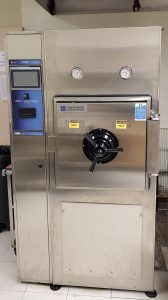
An effective way to decontaminate waste is required for all biological laboratories regardless of containment level. For the vast majority of laboratories this is accomplished using an autoclave which utilizes pressurized steam to sterilize waste, equipment, or other materials. All autoclave operations and procedures should abide by the following guidelines below.
General Guidlines
- Individuals utilizing the autoclave must be trained in the proper operation and safe practices before starting work.
- Adequate PPE should be utilized such as liquid and heat resistant gloves, lab coats, aprons, face protection, and eye protection as determined by risk assessment.
- Do not autoclave animal carcasses, sealed containers, flammable chemicals, volatile chemicals, bleach, or radioactive material. Please note that certain plastics can produce toxic gases, do not autoclave the following plastics: Polyethylene (PETE, Recycle #1), High Density Polyethylene (HDPE, Recycle #2), Polyvinyl Chloride, and Polystyrene.
- Manufacturer’s recommendations for operation and maintenance are followed
- Autoclave is loaded so that steam can penetrate all material inside the chamber. Do not allow any part of the load to touch autoclave vessel walls.
- Lids on containers should be loosely closed or opened and covered with aluminum foil to prevent overpressurization. Biohazard bags should be loosely closed.
- Select the proper autoclave cycle so decontamination of material is achieved, typical cycles include:
- A liquid cycle – used for a load primarily composed of liquids. Pressure is slowly changed to prevent boil-over of liquid from containers.
- A dry cycle – used for a load that is entirely composed of dry material or glassware. Pressure is changed quickly to save time since the materials can withstand the changes.
- A porous cycle – used for a load composed of porous materials such as caging or animal bedding. This cycle partially reduces pressure prior to steam application which allows for increased steam penetration.
- Select the proper decontamination cycle time (dwell time) for the load. Larger loads typically require more time for decontamination.
- Material that is set to be autoclaved should be processed according to the manufacturer recommendations or at 121°C for a minimum of 60 minutes unless shorter intervals have been proven effective with biological indicators.
- Drying cycles, if available, do not decontaminate. Do not use drying cycles on liquid loads as boiling over can occur.
- A logbook is maintained for the autoclave unit that includes the following:
- Autoclave user
- Date used
- Material decontaminated
- Quantity of material decontaminated
- Process type
- Run time/cycle time
- Chemical/biological indicator used as well as changes (if any) observed
- Autoclave Validation or spore test should occur monthly using an adequate challenge strain for the parameters used.
- A simulated load that mimics the material expected to be decontaminated (sans any biohazardous material) should be made up (e.g microisolator cages and bedding).
- Validation should be conducted for each cycle used that differs in temperature, time, or any other parameter.
- An autoclave should not be used until it has been validated.
- Chemical indicators should be utilized in every load.
- Autoclave Containers should be of the appropriate type for the run parameters.
- Do not place loose items directly on autoclave racks, secondary containment that can withstand the high autoclave temperatures should be utilized.
- Actively inhibit any odors that may be present during the course of decontaminating materials.
- Do not leave materials sitting out for long periods of time
- Add odor control additives to loads such as unused animal bedding as necessary
- Once an autoclave cycle is complete be sure the pressure in the chamber is zero before opening the door. Open the door slowly and stand to the side allowing steam to gradually escape. Allow load to cool prior to handling.
- A comprehensive video on autoclaves can be found here
Autoclave Waste Disposal Guidelines
All autoclaved solid waste should be placed in the appropriate labeled containers located at the autoclave sites. Only contaminated solids that have been properly autoclaved should be disposed of in these containers. For verification that the material has been properly autoclaved please use color change autoclave tape or other means to allow for easy identification of autoclaved materials as explained in the previous section.
If for some reason your lab has contaminated material that cannot be autoclaved prior to disposal, please contact ESH for disposal considerations of the material. Do not place contaminated material that has NOT been autoclaved in general trash(black bag) or in the autoclaved only waste stream.
Materials that should NOT be disposed of in autoclaved trash containers are as follows:
- Free Flowing Liquids or Containers of Free Flowing Liquids
- Depending on the liquid there are different methods for disposal. Contact ESH for disposal considerations.
- Chemicals or Chemical Containers
- For proper disposal, chemicals should only be disposed of through ESH. Contact ESH for disposal considerations.
- Chemical containers, depending on the prior contents, may be disposed of as general trash as long as they are 100% empty, not from P-listed material, and the label has been properly defaced (illegible by crossing out or painting). Contact ESH for disposal considerations.
- Sharps or Sharps containers
- Loose sharps should only be disposed of in an appropriate sharps container. A pickup request should be sent to ESH for disposal when 3/4 full or less. NEVER fill a sharps container past 3/4 of its total volume.
- General Trash
- Also known as black bag trash, should be disposed of in accordance with general trash procedures.
- Broken Glassware
- Clean uncontaminated glassware should be disposed of in a sturdy, bagged broken glassware box (bag inside of box). When full it should be adequately sealed with packaging tape and disposed of as regular trash.
- Carcasses
- Should be double bagged and placed in the appropriate freezers exclusive to animal carcass collection until pickup occurs. Contact ESH for disposal considerations.
Please contact UMBC ESH 5-2918 esh@umbc.edu for questions, concerns, or disposal considerations.